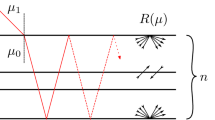Abstract
The infinite medium Green’s function is used to solve the half-space albedo, slab albedo and Milne problems for the unpolarized Rayleigh scattering case; these problems are the most classical problems of radiative transfer theory. The numerical results are obtained and are compared with previous ones.
Similar content being viewed by others
Avoid common mistakes on your manuscript.
1 Introduction
Radiative transfer theory can be applied to many different areas in physics, for example, oceanography, tissue optics, and astrophysics. The radiative transfer equation defines the photon distribution in a scattering, emitting and absorbing medium. The time-independent, monoenergetic radiative transfer equation in plane geometry for the unpolarized case can be written as (Pomraning 1970)
where \(I(\tau ,\mu )\) defines the angular intensity, \(w\) is the single scattering albedo, \(f(\mu ,\mu^{\prime })\) is the scattering phase function, \(\mu \) is the cosine of the direction, \(\tau \) is the optical variable and \(S\) is the source function. In the literature, many methods, such as Case (which was developed to solve the linear transport equation), \(F_{N}\), \(C_{N}\), \(P_{N}\) and \(H_{N}\), have been used to solve this equation for different problems, such as the half-space albedo, slab albedo and Milne problems (Case and Zweifel 1967; Siewert and Beonist 1979; Grandjean and Siewert 1979; Beonist and Kavenoky 1968; Kavenoky 1978; Case et al. 1953; Tezcan et al. 2003).
Rayleigh scattering occurs when the incident wavelength is greater than the size of the scattering particles. Lord Rayleigh explained why the sky is blue and sunset is red by using this scattering function. This scattering function can be used in astrophysics, oceanography and tissue optics. Chandrasekhar formulated the scattering function for the polarized case using the Stokes parameters (Chandrasekhar 1950). The scattering function can be written for the unpolarized Rayleigh case in the following form:
This scattering function has the same form as the quadratic scattering kernel. This kernel has been used to solve some physical problems in the neutron transport equation by using the \(H_{N}\) method (Türeci and Türeci 2007, 2017; Türeci and Güleçyüz 2008; Türeci 2010a, 2010b; Türeci et al. 2012). If we choose \(a=1\) and \(b=1/8\), then we can obtain the unpolarized Rayleigh scattering function (Pomraning 1969, 1970). Substituting this scattering function in Eq. (1) for \(S=0\), the solution of this equation can be found in terms of Case’s singular eigenfunctions. It is assumed that
Thus, the discrete and continuous eigenfunctions are obtained as
where \(P\) is the Cauchy principle value, and \(\alpha_{0}\), \(\alpha \) and \(\lambda (\nu )\) have the following forms:
The full-range orthogonality relations for these eigenfunctions are
Here,
In this paper, the half-space albedo and slab albedo problems are solved by using the \(H_{N}\) method, and the Milne problem is solved using the \(C_{N}\) equations (Beonist and Kavenoky 1968; Kavenoky 1978; Tezcan et al. 1999).
2 Half-space albedo problem
One of the well known problems is the calculation of half-space albedo. The half-space albedo and slab albedo problems can be solved by using the \(F_{N}\) method. In the \(F_{N}\) method, the Placzek lemma defines that any finite medium problem can be converted to the infinite medium problem by inserting a proper source function at the boundaries (Siewert and Beonist 1979; Grandjean and Siewert 1979; Case et al. 1953). In this manner, the infinite medium Green’s function can be used to find the solution of the problems. Applying the Placzek lemma to Eq. (1) for half-space, we obtain (Siewert and Beonist 1979; Grandjean and Siewert 1979)
Then, the solution of Eq. (8) is
The infinite medium Green’s function for the isotropic scattering case is defined by Case and Zweifel (1967):
where the upper signs apply for \(\tau >\tau_{0}\), and the lower signs apply for \(\tau <\tau_{0}\). Here, if we use the discrete and continuous eigenfunctions given in Eq. (4), then we obtain the infinite medium Green’s functions for the Rayleigh scattering case.
In the half-space albedo problem, a scattering/absorbing medium is at \(\tau >0\), and vacuum is at \(\tau <0\). The boundary conditions are
We can write the exit distributions of the photons by using these conditions in Eq. (9) for \(S(\tau_{0},\mu_{0})=0\):
Multiplying both sides of Eq. (12) by \(\mu^{m+1}\) and integrating over \(\mu \in [0,1]\), we can obtain
where \(T_{ml}\) and \(R_{m\beta }\) are defined as
and
Albedo is given by
The unknown \(a_{l}\) expansion coefficients in Eq. (17) are obtained from Eq. (13).
3 Slab albedo problem
Let us consider a plane-parallel medium surrounded by vacuum on both sides at the boundaries with \([-\tau_{0}, \tau_{0}]\). In the \(F_{N}\) method, Siewert and Beonist (1979) defined the following equation:
For \(\tau \in [-\tau_{0},+\tau_{0}]\), \(I(\tau ,\mu )\) can be written as
and can be rearranged into the following form:
Then, for \(S(\tau_{0},\mu_{0})=0\), the exit distributions for \(\tau =\mp \tau_{0}\) are
Assume that photons enter the medium from the left boundary. The boundary conditions are (Siewert and Beonist 1979; Grandjean and Siewert 1979)
By substituting these boundary conditions and the infinite medium Green’s function given by Eq. (10) into Eqs. (20), (21), multiplying each equation by \(\mu^{m+1}\) and then integrating over \(\mu \in [0,1]\), we can obtain the matrix equation for \(a_{l}\) and \(b_{l}\) expansion coefficients:
where
The reflection and transmission coefficients are given by
4 Milne problem
The Milne problem is a half-space problem of determining the photon distribution everywhere in a source-free medium. The photons are emitted from a source at infinity (\(\tau =+\infty \)) into the medium. Vacuum is at \(\tau <0\). At the boundary \(\tau =0\), no photons are entering from \(\tau <0\) inside the medium. Thus,
The third form of the transport equation, also known as the \(C_{N}\) equations, is solved by using the \(C_{N}\) method (Beonist and Kavenoky 1968; Kavenoky 1978) as follows:
The angular flux of a source at infinity is proportional to \(\frac{\nu_{0}}{\nu_{0}+\mu }+\frac{\nu_{0}}{\nu_{0}+\mu }\alpha_{0}(3 \mu^{2}-1)\), and using this with the boundary condition in Eq. (27), we can rewrite the previous equations as
The exit distribution can be defined by
Multiplying both sides of Eqs. (29) by \(\mu^{m+1}\) and then integrating over \(\mu \in [0,1]\) and \(\mu \in [-1,0]\), we can obtain the following equations (Tezcan et al. 1999):
The asymptotic flux can be written as a summation of the source at infinity and the source at the surface:
where
The extrapolated endpoint is obtained from the relation (Case and Zweifel 1967)
and can be written as
The unknown coefficients in this equation, \(a_{l}\), are obtained from Eqs. (31a), (31b). The extrapolated endpoints have the same numerical results for both equations.
5 Conclusions
\(F_{N}\) and \(C_{N}\) equations were used to solve the half-space albedo, slab albedo and Milne problems for the unpolarized Rayleigh scattering case. The \(H_{N}\) method was applied to these equations by using the infinite medium Green’s function. The numerical results were compared with previous results. Some results were found to be in good agreement with Türeci (2010b); these results were obtained for the maximum eighth degree of approximation. In this reference, the quadratic scattering function was used to solve the neutron transport equation for different values of the scattering coefficient, \(f_{2}\). Here, \(f_{2}=0.1\) corresponds to Rayleigh scattering. The numerical results of half-space albedo for the unpolarized case were also compared with the results of Schnatz and Siewert (1971) and Şenyiğit (2016). Our numerical results were found to be slightly different from their numerical results (Tables 1 and 2). The reflection and transmission coefficients were found to be in good agreement with the results of Abdel Krim et al. (1992) (Tables 3, 4 and 5). The numerical results of the Milne problem were obtained by using Eqs. (31a), (31b) and were compared with the results of Türeci (2010b) for \(f_{2}=0.1\). However, to our knowledge, no work in the literature considered the unpolarized case of Rayleigh scattering. Thus, the numerical results of the unpolarized case were compared with the results of the polarized case to gain insight into its behavior. We obtained numerical results up to the 30th approximation to test the convergence (Tables 6, 7, and 8).
References
Abdel Krim, M.S., Abulwafa, E.M., Shouman, S.M.: Astrophys. Space Sci. 189, 279 (1992)
Beonist, P., Kavenoky, A.: Nucl. Sci. Eng. 32, 225 (1968)
Case, K.M., Zweifel, P.F.: Linear Transport Theory. Addison-Wesley, Reading (1967)
Case, K.M., Hoffmann, F.D., Placzek, G.: Introduction to the Theory of Neutron Diffusion, Vol. I. Los Alamos Science Laboratory, Los Alamos (1953)
Chandrasekhar, S.: Radiative Transfer. Clarendon Press, Oxford (1950); reprinted: Dover, New York (1960)
Grandjean, P., Siewert, C.E.: Nucl. Sci. Eng. 69, 161 (1979)
Kavenoky, A.: Nucl. Sci. Eng. 65, 209 (1978)
Pomraning, G.C.: Astron. Astrophys. 2, 419 (1969)
Pomraning, G.C.: Astrophys. J. 159, 119 (1970)
Schnatz, T.W., Siewert, C.E.: Mon. Not. R. Astron. Soc. 152, 491 (1971)
Şenyiğit, M.: Astrophys. Space Sci. 361, 318 (2016)
Siewert, C.E., Beonist, P.: Nucl. Sci. Eng. 69, 156 (1979)
Tezcan, C., Kaşkaş, A., Güleçyüz, M.Ç.: J. Quant. Spectrosc. Radiat. Transf. 62, 49 (1999)
Tezcan, C., Kaşkaş, A., Güleçyüz, M.Ç.: J. Quant. Spectrosc. Radiat. Transf. 78, 243 (2003)
Türeci, R.G.: Kerntechnik 75, 292 (2010a)
Türeci, D.: The semi-analytical methods for the neutron transport equation and its applications. PhD Thesis, Ankara University (2010b)
Türeci, R.G., Güleçyüz, M.Ç.: Kerntechnik 73, 171 (2008)
Türeci, R.G., Türeci, D.: Kerntechnik 72, 59 (2007)
Türeci, R.G., Türeci, D.: Kerntechnik 82, 239 (2017)
Türeci, D., Türeci, R.G., Teğmen, A., Güleçyüz, M.Ç.: Kerntechnik 77, 60 (2012)
Author information
Authors and Affiliations
Corresponding author
Rights and permissions
About this article
Cite this article
Biçer, M., Kaşkaş, A. Solution of the radiative transfer equation for Rayleigh scattering using the infinite medium Green’s function. Astrophys Space Sci 363, 46 (2018). https://doi.org/10.1007/s10509-018-3267-4
Received:
Accepted:
Published:
DOI: https://doi.org/10.1007/s10509-018-3267-4




